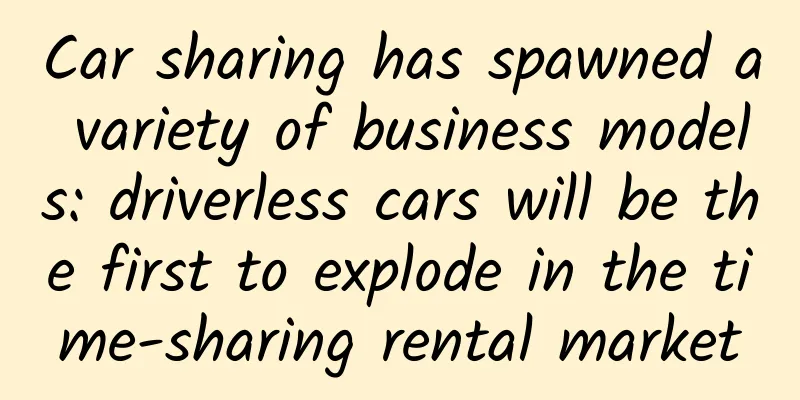How I use WeChat to operate a "social product" with more than 20% daily active users

|
In everyone’s mind, Internet products are generally an APP, a public account derivative page, or a small program . However, I wonder if you have ever seen a product that is directly supported by WeChat ? This incident took place between December 2015 and August 2016. Although more than a year has passed, Yaoyao still has concerns about this product that was completely " operated " by Yaoyao rather than designed. Because it does meet the needs of some people and has achieved very high daily activity results. Because of the unique product concept and rule design, the product and team were reported by various media including 36Kr and CCTV. Therefore, this article will recount the development history of this product called "Elk". one,That day, I was having dinner and chatting with a product manager friend, and somehow we talked about an idea. He said, "If we get several people who have different opinions on the same thing together for a group chat, wouldn't it be possible to generate a lot of conflicts and discussions? There should be a lot to say, right?" Although my friend's idea may have just been a flash of inspiration, it planted a seed in Yaoyao's heart. Yaoyao quickly followed this idea and thought of a set of test operation processes, wanting to see whether there is a demand for such a scenario and whether it can provide value on a continuous basis. First, you need to use Ali Xiaohao to get a mobile phone number. I registered for WeChat and, according to the idea that came to my mind at the time, I randomly gave it a name called “Miaoliao”, which means starting a chat and ending it in the blink of an eye. Well, it’s the same usage as the “miao” in “miaoshe”. The design is basically to use this WeChat account to obtain friend relationships, then send a topic to them in a group, and then pull those who are interested in the topic into a group to chat. When the chat is over at the expected time, the WeChat group will be disbanded to terminate the chat. The first time, I designed a group of 6 people for a 6-minute chat. Don't ask me why it was 6, because at that time I didn't know how many minutes and how many people would be appropriate, so I just picked a lucky number hahahahaha. Then I posted a topic poster through my WeChat account, with the topic "Do you think teaching is a good profession?", and attached a QR code of the Miaoliao WeChat account to the poster. (The reason why I used this topic on the first night was because it was a graduate from a normal college, um, the school that Teacher Ma went to, so there were many friends in my circle of friends who were or were about to become teachers. It was easier to acquire the first batch of seed users by releasing such a precisely targeted topic.) After the topic was posted at around 8 o'clock that night, 6 people added WeChat to join the group chat. I then deleted the topic poster in my circle of friends to control the chat among the 6 people to 6 minutes. The topic started, and the debate about whether being a teacher is a good profession quickly broke out in the group, but because there were few people, the chat in the group was intermittent. Soon the 6 minutes were up, and as planned, I simply informed everyone in the group that "the 6 minutes for tonight's topic discussion have expired, and I will disband the group. Everyone is welcome to pay attention to the topics posted by Miaoliao next time." Then I kicked all the users out of the group one by one. (Because WeChat groups can only be disbanded by kicking people out.) Finally, I visited each user who participated in the event one by one, and the feedback I got was mainly: Li Hao: "I think this format is very novel, I like it very much, and I hope to continue it tomorrow night." Disadvantages: "Too few people, too short a time, it ended before it even started." Obviously, the feedback told us that there was nothing wrong with this direction, but the setting of 6 people and 6 minutes was really a big problem. So we decided to change the number the next night to 20 people and 15 minutes. So the next day, I had to find a few friends to forward the topic pictures to attract new users. After each new user is added to WeChat, Yaoyao will manually reply with a paragraph to introduce what the Miaoliao product is: "Welcome to follow Miaoliao. At 8 o'clock every night, we will release some topics. Select the topic you are interested in and reply to the topic number to automatically enter the group chat to discuss the topic." Then a introduction picture with a QR code will be sent for users to spread by themselves. I designed fixed response texts for each user's operation, so from the user's side, everything seems automatic. Unless the user wants to chat or give other opinions, he will suddenly realize: "Oh, you are not a robot." The next night, I repeated the operations of the previous day: adding new users - creating topics - sending topic pictures to all WeChat friends - adding users to groups based on user replies (the user reply here means that when the user is interested in the topic released tonight, he/she will reply 1 to indicate that he/she wants to join the group chat) - organizing discussions after adding the group - informing the group chat that it is over after the specified chat time and then kicking everyone out one by one. It can be found that this operational closed loop has been formed, and there is a clear and fixed method for starting and ending this group chat. Although the gameplay is very novel and requires a user education process, the education is not complicated because the user's operating behavior is relatively simple. Basically, after a new user replies "1" on the first night, he will be automatically added to the group, see how everyone chats, know how to end the group chat, and then he will basically know what kind of product this is. Although it sounds simple, in order to make all processes smooth, operations completely replace product operations, so operations are particularly complicated. Step 1: Determine the topic (this is really not an easy thing to do). Step 2: Select the topic background that needs to be enriched and post it to the circle of friends for preview (daily warm-up). Step 3: Create a WeChat group for each topic before 7:15 and set the group name to [1] XXXXXXX (topic name) Step 4: At 7:20, use the WeChat group sending assistant to send the topic promotion picture to all users. After receiving the user's response, confirm the user's choice. Step 5: Record the reply numbers of all users and create groups one by one. When you find that hundreds of users are replying to you with numbers at one time, you will know what collapse is. Step 6: Start the group chat at 8:00 on time, organize it strictly, and publish fixed host words. Step 7: When the notification time is up, kick out users one by one to disband the group chat. Step 8: Count the new, active, and old user activity data (because it is an operational product, all data is not automatically available and must be counted manually. Step 9: Interview new users. Every interview with new users can let you know which part is not done well, and can also make new users more accepting of your product. (The picture shows the new user survey records for each period and a screenshot of one of the survey records) I would even manually record which topics each user had participated in for data analysis and manually understand user preference tags. (The figure shows the record of topics that each user has participated in) two,I know that after reading this plan, you will have many questions. Let me explain them one by one. 1. Why did you want to disband? Wouldn’t it be better to keep chatting and build up user relationships? Because I feel that for a product that requires users to spend a lot of time using it, it is very important to be moderate and learn to exercise restraint. Leaving a feeling of wanting more will bring the best experience. In the early stage, Yaoyao would basically conduct survey feedback on every new user who participated in the group chat after the end of the night. Some users also reported that they hoped to continue the chat. Yaoyao was also shaken, but later facts proved that the desire to continue could bring a better experience and could also very effectively extend the product life cycle . If you give too much, the user will consume it all at once and will never want to come again. It's like if you like drinking milk very much, and today I give you a ton of milk for you to drink, you may never want to drink milk again. However, if I give you 3 sips of milk every day and no more, you will feel that milk is so precious, and it tastes so damn good every time you drink it, and you will never get tired of drinking it every day. 2. What was the final value for the time and number of people? This issue was where I made the most adjustments at the beginning. Based on the user feedback I continuously collected and after more than 10 days of adjustments, I found that the most stable number of people chatting is 15-20, and the most appropriate chat time is also around 15-20. If there are not enough people, the conversation will be difficult, and if there are too many people, it will be very chaotic. The previous sentence will not make sense and the next sentence will be the next one. If the time is too short, the chat will end. If the time is too long, people will get tired of chatting and the group will gradually become silent, and the experience will not be good. (The picture shows the user survey data record) This was debugged from the perspective of user feedback, but it can also be explained from a theoretical perspective: usually the ratio of people discussing and watching in a small community also conforms to the 2/8 principle, that is, 20% of users will participate in the discussion and speak, and 80% of users will only watch or speak occasionally. So if there are 20 people in the group, 20% is about 4-5 people. You will find that many large groups on your mobile phone are also like this. Generally, there are about 4-5 people talking at the same time. 2-3 people chatting is not very lively, but it is not common to have more than this number of people in the group chat. Therefore, the total number of 20 people can be converted into an active value of 4-5, which is very scientific. The practical test is consistent with the theoretical value, which is perfect. 3. In this mode, it seems that the topic is the core. If no one is interested in the topic, then no one will want to participate in the chat, right? That’s right! ! This model itself is a topic discussion model. So everything is closely centered around the topic. In this regard, we need to continuously adjust the direction of topic settings through daily numerical feedback and survey feedback from the number of people participating in the topic. (The picture shows the analysis record of each topic) After testing thousands of topics, we can conclude that a topic needs to meet or partially meet the following conditions to achieve a better group chat effect:
In addition to the above, there are actually many requirements for discussing a good topic in detail. Therefore, when we need to convey the "sense of topic" obtained from thousands of topic data and user feedback to the team's operations partners, it is difficult to explain clearly why this topic is good and why this topic is not good. Therefore, [Yaoyao Notes] will write a separate article to discuss in detail how to do community UGC , so I won’t go into details here. 4. To what extent did it develop later? Why didn't it continue to go down? After Miaoliao was operated on WeChat for about 2-3 months, its user stickiness and retention were very high. Daily active users (referring to users who reply to the topic number to participate in the group chat after the topic is posted every day) can reach about 15%-25% of the total number of users on the WeChat account, and the final total number of users is about 1,500. Moreover, we stopped operating for 7 days during the Lunar New Year, but the number/ratio of active users before and after the suspension did not change at all, which shows how strong the stickiness is. So around March after the Chinese New Year, the team designed and developed the Miaoliao APP based on the Miaoliao model on WeChat, and renamed it "Elu". Why is it called elk? At the beginning we proposed more than 300 names, but our great designer boss (the man in the header picture of this article who was interviewed by CCTV) suggested using a familiar word to name the product, and came up with the interesting "four-legged animal" of elk. After checking Baidu Encyclopedia , we were surprised to find that Baidu Encyclopedia describes the habits of elk like this: "The fights between male elk for mates are relatively mild, without fierce collisions and large-scale movements. The fight usually lasts no more than 10 minutes. The loser simply turns around and walks away, and the winner no longer chases after him." This is truly a fateful coincidence, the habits of this animal are very similar to the characteristics of our products. So we decisively decided on this new name. Then, after agile development, we launched the APP and gradually directed users on WeChat to the APP. So here comes the question. Where to find new ones? You will find that we have only gained about 1,500 people after operating on WeChat for 2-3 months. This growth is actually quite low. The main source of this is that the operating method encourages users to spread the word spontaneously, but due to the small base of dissemination, it is impossible to simply explain what kind of product this is when disseminating it. Our small startup company does not have sufficient funds to invest in a large number of channels , so the growth is very weak. After using the APP, this problem becomes more obvious. Moreover, as a young product person, we proudly set the APP to "require application to register". Users entering the APP need to answer the topics we set and pass the operation review before they can complete the registration and enter the APP. Because at that time, we felt that the experience of this product itself determines whether people in the same group think and express at the same level. If you let an elementary school student and a doctoral student discuss a topic, there will be an obvious repulsion. It is only a matter of time before the pros and cons drive out the good money. So now I can’t really tell whether this “suicidal” setting is good or bad. ( The far right is a picture of a user's long thank you note) Because of the core problem of growth, the elk died in the end. When Milu announced the suspension of operations, a large number of users posted messages to express their gratitude and reluctance, and finally recognized us, for which we are still very grateful. The author of this article @要要 is compiled and published by (Qinggua Media). Please indicate the author information and source when reprinting! Product promotion services: APP promotion services, information flow advertising, advertising platform |
>>: With a little resources, I want to do too many things!
Recommend
Programmer: Why don’t I recommend you to go to an outsourcing company?
[[138822]] In fact, we all know clearly that &quo...
How do we control the rocket after it's launched?
I said before that rockets and carrier rockets ar...
Rolls-Royce pure electric SUV with a range of 960 kilometers may be unveiled in 2019
Recently, overseas media reported that Rolls-Royc...
Google will no longer support Google services on Android 2.3.7 and below
Google announced that starting from September 27,...
What is "i人e人"? Can MBTI really define us?
I don’t know when it started, but MBTI is everywh...
The students who are "trapped" in their seats are becoming more and more "fragile"...
Hemorrhoids are a very common anal condition, and...
Operational tips: In the early stage of promotion, should we use WeChat or App?
The author of this article is Qianniu Xujin, form...
Popular Science Illustrations | New discoveries by Zhurong reveal the superficial structure of Mars
...
How to drink water to be healthy? Don't be misled by it. Let's learn from it.
We all know that the most important elements for ...
An unheard of brand becomes the leader in Indian mobile phones, and Americans are shocked again
[[127466]] To be honest, the American media now h...
If your organs could talk, how would you be scolded every day?
Review | Li Nannan Director of Hunan Science Writ...
During the Spring Festival, children must be protected from the safety hazards of fireworks and firecrackers!
Fireworks and firecrackers often cause injuries d...
If you find this kind of rice, you must protect it! It is as precious as the giant panda
If you come across a weed-like plant in the wild ...
Xbox One system detailed analysis: the complete Windows 8
A few months ago, several news outlets reported th...
A complete analysis of MINISO's private domain
Since its establishment in 2013, MINISO has alway...









